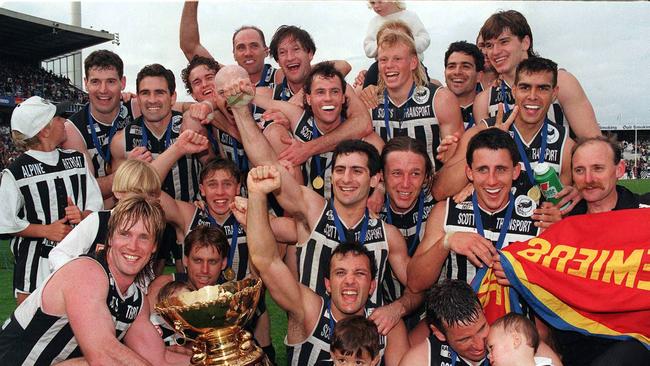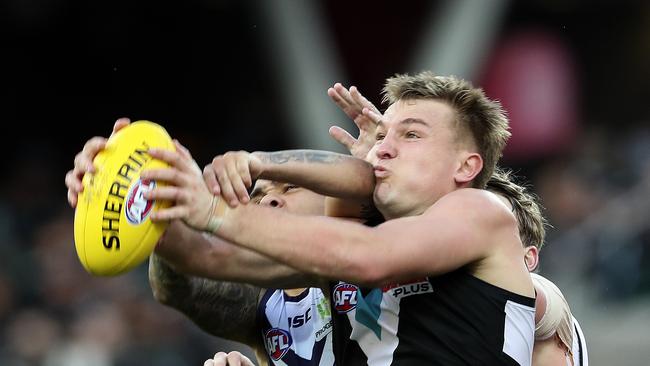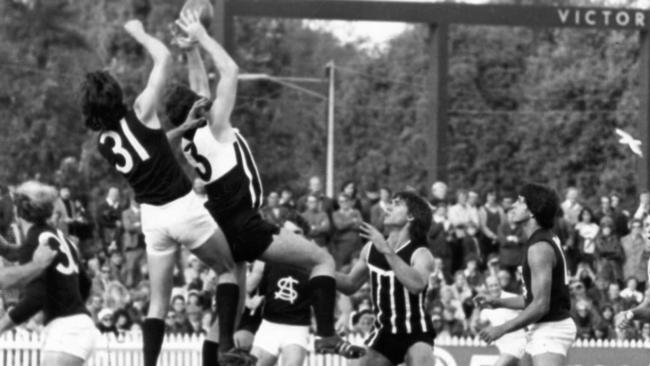How an Advertiser selection panel determined Port Adelaide’s 150 Greatest Players from club’s 150 years
This week The Advertiser named its list of Port Adelaide’s 150 Greatest Players. Now, selection panellist Matt Turner reveals how players were picked, tough calls and who caused the most debate.
Port Adelaide
Don't miss out on the headlines from Port Adelaide. Followed categories will be added to My News.
- Port Adelaide’s 150 Greatest Players revealed
- How to get the most out of your Advertiser digital subscription
It took only a few minutes into the first meeting to start determining Port Adelaide’s 150 Greatest Players for the magnitude of the task to hit home.
“This is going to really hard,” three-time Port premiership skipper and former chief executive Brian Cunningham said.
The Advertiser had approached Port late last year about picking its standout players since the club’s formation in 1870, as part of its 150th anniversary celebrations in 2020.
In Alberton Oval’s board room in late January, the first meeting laid bare what needed to happen – cutting a list of 1554 players who have lined up in a SANFL or AFL match for Port down to just 150.
To do it, a panel was formed, featuring four Port greats from different periods – 1950s and ‘60s ruckman Bob Philp, 1979-81 premiership captain and 1992-2004 chief executive Cunningham, 1994-96 flag-winning skipper Tim Ginever and four-time All-Australian Power star Warren Tredrea – along with the club’s historian Mark Shephard and media manager Daniel Norton, as well as Advertiser reporter Matt Turner.
The group was to only judge players on their contributions for Port, not what they did at other clubs or as coaches or administrators.
Its first step was narrowing the list.
Any 100-gamers, multiple premiership winners, Magarey Medallists, captains, leading goalkickers or best and fairests were automatically in the “to be considered further” pile, as were other notable players who did not tick any of those boxes.
That ensured names such as Dwayne Russell, Drozena Eden, Alan Hender, Andrew McLeod, Richard Turpenny, Alf Bushby and George Gliddon would not be overlooked.
Using that criteria, the initial list of 1554 was whittled down to about 270 by the second meeting a fortnight later.
Shephard created a giant spreadsheet for the panel with key statistics and historical information on each of the players who remained under consideration, and brought vital knowledge on the club’s earliest stars.
It was determined, after looking through the list of names that fit these categories, that anyone in Port’s or the SANFL’s Hall of Fame as a player, or nominated for the club’s Greatest Team would be immediately chosen in the 150.
That elevated 62 players, including superstars like Russell Ebert, Bob Quinn and Geof Motley.
More difficult was filling the other 88 spots.
The panel started with the ones everyone agreed should go in, assessing the players based on factors including on-field performances, ability, longevity, flags, individual achievements, selflessness, passion and contribution to success.

Port’s motto of “we exist to win premierships” meant being in winning grand finals was looked on favourably, but so was how the club rated the players, particularly in best and fairests.
And not just who finished first either.
Cunningham noted some players, such as Darrell Cahill, never claimed a best and fairest but regularly finished in the top few spots and that should be looked on favourably.
As the panel glanced through the spreadsheet, the debate intensified.
“I went through with a blue pen and there was 22 dead certainties,” Philp said.
The response came quickly: “Only 22?”
It was a sign of things to come from Philp.
He might be a larrikin, but he was to be the toughest judge and names were not going to get through him easily.
His trademark retort when a player he deemed not quite good enough was mentioned was “he can’t make it”.
It was usually followed by “I’ve already told him he isn’t in there”, if it was a former teammate.
Sometimes it was difficult to tell if Philp was joking, particularly when his assessment of every player from the 1950s and ‘60s often came with a memory of them, complete with nicknames, that would always get a laugh.

After going through the list, one name at a time, another 28 players were added.
They happened to cover all eras of the club’s history.
From John Sidoli, who was in Port’s inaugural side in 1870, to 1970s wingman Kym Kinnear, 1999 premiership captain David Brown and reigning best and fairest Travis Boak.
That left 34 more to squeeze in and they were the toughest calls.
Among those who caused the most debate were David Gill, Brayden Lyle and Ollie Wines.
Philp, who played with Gill, flip-flopped on whether he should be in before deciding that his premiership record and “being a teammate you’d want in the trenches with you” warranted selection.
Lyle only featured in 90 AFL games but the panel believed his leadership in the Power’s first two seasons was crucial and an intangible quality that would not show up in statistics.
At just 25 and midway through his career, Wines was always going to be an interesting case.
But his best and fairest record – twice a runner-up, sixth twice and 10th once – and his grunt work in some big wins for the club, such as three goals and 26 disposals in 2014 semi-final away against Fremantle, supported his inclusion.
With a project of this scale, a player’s contribution and the panel’s majority view had to override sentimentality or personal favourites.
Key forward Randall Gerlach, who was forced to retire at the age of 24 in 1977 due to a debilitating kidney condition, after playing that season against doctor’s advice, was among the final 34 additions and chosen on how he fit the criteria, not nostalgia.

“When you’re talking about greatest, he sacrificed and risked his life for the football club,” Cunningham said.
Narrowing it down to 150 was incredibly difficult.
The list of near-misses is long and includes close friends of the ex-players on the panel, well-known club stalwarts and multiple premiership winners.
It was not until last week, after the group’s sixth meeting and first via video conference app Zoom, that the 150 was settled.
It was never an intention to have a particular amount from certain eras.
Ultimately, the 150 featured 50 players whose careers were largely from 1870-1950, 40 from 1950-80 and 60 from 1980-today.
Comparing eras, let alone players, was tricky but with the club believing the 2004 premiership was the pinnacle, that needed to be taken into account.
It is worth noting that Tredrea, Cunningham, Ginever and Philp have left the room, or in recent weeks the virtual meetings, when their names have been discussed.
Debate has already begun about the list since being released online this week.
It is only likely to increase next week when we start counting down the 50 greatest, 10 players at time, at advertiser.com.au.

